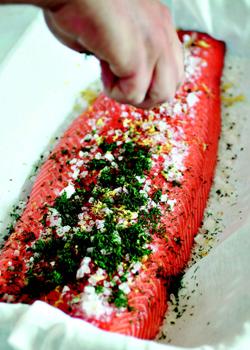The word gravadlax comes from “grav” meaning grave and “lax”, which is salmon. The fish was originally salted, fermented and buried in sand. Today, of course, it tastes and looks much better than it did during the Middle Ages. The freshest salmon must be used for gravadlax and I prefer to use Loch Duart salmon from Scotland.
Although not from Scandinavia, it is probably some of the best farmed salmon on the market. I have used one whole side of salmon but you can use a smaller piece and adjust your recipe accordingly. The cure mixture will depend on your own preference as to how sweet you want it and how moist it should be. More salt will result in a dryer end-result.
Cured salmon
Ingredients
- 1,4kg salmon fillet, skin on
- 20ml gin or vodka
- 15ml fresh dill, chopped
- zest of 1 lime
- CURE MIXTURE
- 170g coarse salt
- 170g sugar
- 15ml white pepper, crushed
- 40ml fresh dill, chopped
- zest of ½ lemon
- SAUCE
- 45ml grainy mustard
- 15ml sugar
- pinch of salt
- 15ml red wine vinegar
- 45ml fresh dill, chopped
- 50ml olive oil
Instructions
Remove the pin bones from the salmon.Line a large container – big enough for the salmon to fit in – with a piece of cheesecloth and set aside.
Combine the cure mixture and sprinkle half of the mixture over the cheesecloth.
Brush the salmon with the vodka and lay it on top of the cure mixture, skin-side down. Spread the remaining mixture evenly over the salmon, placing less cure mixture at the tail as this will result in the tail being overcured compared with the rest of the fish.
Bring the cheesecloth over and wrap the fish tightly. Put a weight on top of the fish to keep it down, and refrigerate.
Leave refrigerated for 2 – 3 days depending on your preference.
Scrape off the mixture – I like to rinse the side of salmon – and pat dry.
Sprinkle the dill and zest over the salmon, pressing lightly. Refrigerate until needed.
To make the sauce, whisk together the mustard, sugar, salt and vinegar. Add the dill and oil.
To serve, cut the salmon diagonally towards the tail. Make sure you cut as thinly as possible. Lift the slices and serve with the dill sauce and bread or boiled potatoes, cucumber salad and lemon.
Notes
You can use mayonnaise with mustard and dill instead of making the sauce. If you don’t have cheesecloth use a dish towel or plastic wrap
Other cures:
• Lemon, orange and lime zest
• Raw beetroot with horseradish
• Pepper and fresh coriander

